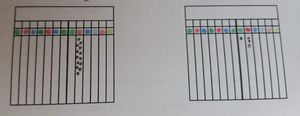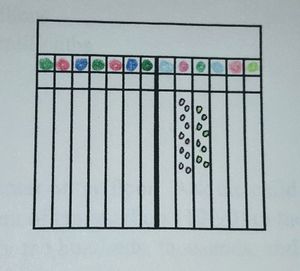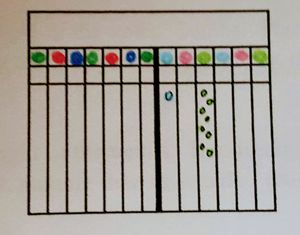Decimals Forming and Reading Decimal Quantities (Lessons 4 & 5)
Contents
Age
9-12
Materials
- Decimal board
- Box of beads and disks
Preparation
Students should have had the Introduction to Decimals, Lesson 1 and Second Presentation of Quantity and Introduction to the Decimal Board and Unit as the Center
Presentation
These lessons are providing an opportunity for the student to be comfortable with decimal place values. These experiences are assisting the student to move toward abstraction.
NOTE: The ability to read decimal numeral or quantities depends on a very solid understanding of the names of each category and the relationships between them.
Therefore, a great deal of time for practice with decimal quantities symbols must be given, so the child can internalize these relationships (basically, don't hurry written words too fast).
First Presentation (Lesson 4):
- 1. Place several beads representing whole numbers (e.g., four hundred) on the board and have the student read the quantity: "four hundred". continue with more complex quantities, still composed entirely of whole numbers, until the student is familiar with the whole number side of the board.
- 2. Place two beads in the units column and three blue disks in the tenths column. Ask the student to read this quantity, one column at a time: "two units and three tenths"
- 3. Continue with several other quantities on this level of difficulty.
- 4. Begin forming quantities with hundredths also asking the student to identify them (e.g., "six units and four tenths and two hundredths") NOTE: At this point this is an acceptable answer, since the purpose is to solidify the names of the different place values/categories.
Continue with several more of these.
- 5. Review this much by saying a quantity and having the child form it with the beads: "seven units and three tenths and nine hundredths"
- 6. Have the students form a quantity and name it themselves.
- 7. During later presentations, or now if appropriate, continue into thousandths and other decimal places.
Second Presentation (Lesson 5)
- 1. Review a couple quantities from the previous presentation, for instance, asking the student to form three units and eight tenths and six hundredths.
- 2. Now as the student to put out thirteen hundredths. The student will probably place thirteen red disks in the hundredths column.
- 3. Say, "We can't have thirteen hundredths this way." Give the student a chance to see if they can be arranged another way. If students can't see what to do, tell them: "We have more than ten hundredths here; what does ten hundredths equal?" (one tenth). Have them make the exchange:
- 4. Give several other examples such as this, then try an example like "twenty four thousandths" (Here the exchange will have to be made twice, and the students will end up with two hundredths and four thousandths). Try several other challenges like this, increasing the level of difficulty as it seems appropriate.
The presentation can stop here, or you can go on to the next step.
- 5. Say, "Take a deep breath! Let's put out one hundred eight thousandths!" There may not be enough disks; but ask the students if there is a very fast way to put down ten thousandths with just one disk. Put one disk in the hundredths place: "that stands for ten thousandths." Put out another hundredth disk: "Twenty thousandths." Keep lacing hundredth disks and counting until you reach one hundred thousandths. Say, "The quantity we want here is one hundred eight thousandths; so what do we have to add next?" Have the students add eight disks to the thousandths; column.
- 6. Say, "Let's see how many hundredths we have." Count them-there are ten. "What does ten hundredths equal?" (one tenth). Exchange the hundredths for a tenth disk. "We now have this arrangement: the tenth represents one hundred thousandths; there are one hundred thousandths; there are one hundred thousandths in one tenth."
The total represented on this board is one hundred eight thousandths (0.108)
- 7. Continue with other such quantities, if you feel students need more practice.
Control Of Error
Teacher guided.
Points Of Interest
Participating with the new knowledge helps move the concrete experiences toward abstract thinking
Purpose
- To make a visual, auditory and kinesthetic impression upon the child on how whole numbers are divided into smaller units-decimals.
Variation
Students can recreate the quantities in these lessons in their Math journals.
Handouts/Attachment



